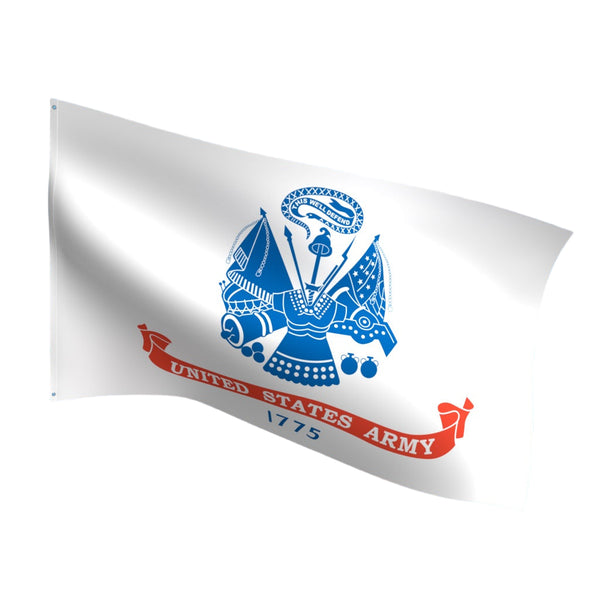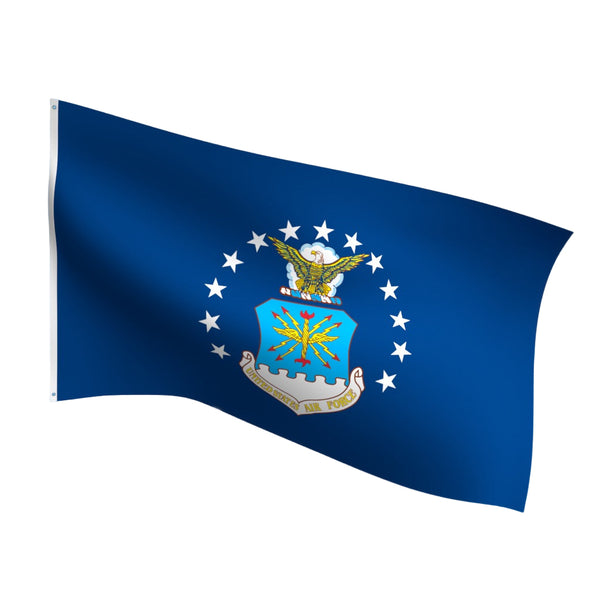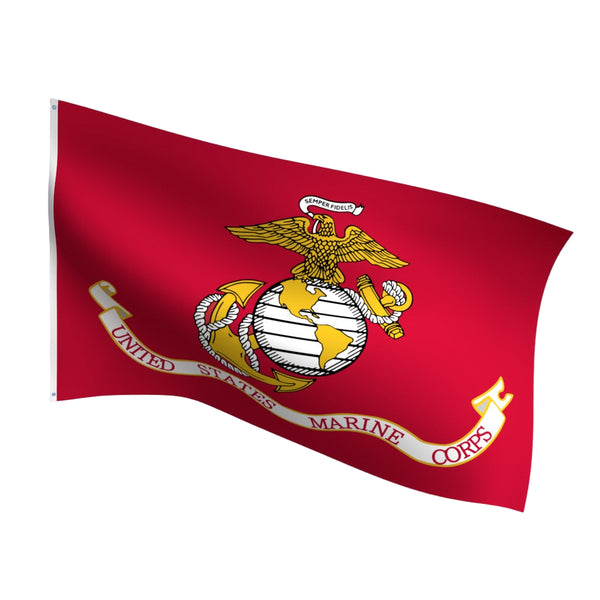The Colors of Service: A Practical, Proud Guide to U.S. Military Flags
Share
The stadium quiets. A drumline snaps to attention. One by one, banners appear at the tunnel: Army, Navy, Marines, Air Force, Coast Guard, Space Force—each colorway carrying history, courage, and sacrifice. You feel it before you think it: these aren’t just fabrics on poles; they’re living emblems of men and women who stood a post so the rest of us could live our lives.
If you’ve ever wondered which military flag to fly, where to place it, how to size it, and why the details matter, this is your field guide—built for families, schools, veteran groups, and businesses that want to display service flags the right way.
Shop all U.S. Military Branch Flags
What Makes a Military Flag “Official” (and Why It Matters)
Military flags represent the identity and traditions of their branch. The official designs—colors, seals, mottos—are standardized by each service. When you buy and fly a U.S. Army, Navy, Marine Corps, Air Force, Coast Guard, or Space Force flag, you’re not just decorating; you’re displaying an emblem that stands for real people and real history.
Why materials matter:
- Outdoor nylon: Flies easily in light wind and dries fast—great all-around choice for most homes, schools, and storefronts.
- Polyester: Heavier and tougher in consistently windy or coastal conditions; better abrasion resistance at the fly end.
- Indoor presentation: Pole sleeve with optional gold fringe for auditoriums, sanctuaries, offices, and ceremonies.
At Tidmore Flags, we focus on USA-made flags with reinforced stitching, durable color, and reliable hardware. Quality shows every time the breeze picks up. All military flags we sell at FMAA Certified.
The Six Branches at a Glance: Army, Navy, Marines, Air Force, Coast Guard, Space Force
U.S. Army Flag

Look: White field with the blue War Office Seal, red “United States Army” scroll and 1775.
Tone: Heritage, discipline, and the oldest lineage in U.S. military service.
Common placements: Schools honoring JROTC programs, government buildings, veterans’ events, Memorial Day and Veterans Day observances.
U.S. Marine Corps Flag

Look: Rich scarlet with the Eagle, Globe, and Anchor; gold “United States Marine Corps” scroll.
Tone: Valor, expeditionary readiness, esprit de corps.
Common placements: Parades, ceremonies, Marine Corps Birthday (Nov 10), USMC family homes, VFW/AL halls.
U.S. Navy Flag

Look: Dark blue with the central seal (ship at sea) above a yellow “United States Navy” scroll.
Tone: Sea power, heritage, and global presence.
Common placements: Coastal communities, schools with naval alumni, shipyard towns, Navy Birthday (Oct 13).

U.S. Air Force Flag
Look: Ultramarine blue with the USAF crest and 13 white stars; gold thunderbolt and wings emblem.
Tone: Air dominance, innovation, speed.
Common placements: Airfields, aerospace communities, ROTC programs, Air Force Birthday (Sept 18).
U.S. Coast Guard Flag

Look: White field with blue emblem and red “Semper Paratus,” plus founding date 1790.
Tone: Search and rescue, maritime safety, coastal security.
Common placements: Marina towns, coastal schools, lighthouse/harbor offices, Coast Guard Day (Aug 4).
U.S. Space Force Flag

Look: Space-black field, delta symbol, orbit path, Polaris star, and “United States Space Force.”
Tone: Guardianship in the space domain—modern, strategic, tech-forward.
Common placements: STEM schools, aerospace firms, defense contractors, Space Force Birthday (Dec 20).
Where to Place Military Flags: Order of Precedence You Can Trust
When flying service flags together, keep the military order of precedence:
Army → Marine Corps → Navy → Air Force → Space Force → Coast Guard
(Note: Coast Guard moves ahead of Navy during times it operates as part of the Department of the Navy.)
U.S. flag placement: The U.S. flag always has the place of honor (highest or most prominent position). If you display a POW/MIA flag, it typically follows the U.S. flag—either directly below it on the same pole or in the next-most-honored position when multiple poles are used. State, city, or organization flags follow.
Indoors: U.S. flag to the speaker’s right (audience’s left). Group service flags together in proper order; don’t split them with local flags.
The “How” of Choosing the Right Military Flag (Material, Size, Hardware)
Outdoors
- Nylon for most locations (light lift, quick-dry, vivid color).
- Polyester for windy/coastal sites (heavier, more abrasion-resistant).
Indoors
- Pole sleeve with optional gold fringe for ceremonies and lobbies.
- Pair with a tasseled cord, eagle/spear finial, and a weighted floor stand.
Typical sizes
- 3′×5′ for porches and wall mounts.
- 4′×6′ for taller homes or storefronts.
- 5′×8′ and above for campuses, parks, and civic buildings.
- Indoor presentation sets are commonly 3′×5′ with 7′–9′ poles.
A Story to Remember: Six Banners, One Community
On a chilly November morning, a small town dedicated its new veterans memorial. They’d ordered six service flags—Army, Navy, Marines, Air Force, Coast Guard, Space Force—plus the U.S. and POW/MIA. The crew mounted eight poles on a gentle arc around the plaza.
At rehearsal, someone suggested mixing the order to match the crowd’s alumni. A retired senior chief shook his head and quietly set the line: U.S. at the center, POW/MIA on the position of honor beside it, then the six branches in the correct sequence.
When the sun burned through the clouds, the brass section played, and families gathered—nobody debated a thing. The arrangement spoke for them: respect first, unity always. Later, a teenager asked his grandfather which one he served under. “Navy,” he said, pointing to the blue field. “But we all stood the watch.” The young man nodded; the display had already taught the lesson.
The One-Glance Shopping List (Quick List for Military Flags)
-
Choose material for your weather:
- Nylon (all-around) or 2-ply polyester (windy/coastal).
-
Pick sizes for your poles:
- 3′×5′ (porches), 4′×6′ (taller mounts), 5′×8′+ (campus/civic).
-
Select indoor sets if needed:
- Pole sleeve, fringe, finial, weighted stand.
-
Group service flags together (keep the order):
- Army, Marines, Navy, Air Force, Space Force, Coast Guard.
-
Add the U.S. flag and (optionally) POW/MIA:
- Place of honor for U.S.; POW/MIA next in prominence.
-
Hardware & care:
- Sturdy brackets/poles, brass grommets, smooth snap hooks, monthly inspection, trim early fray.
Why These Flags Matter: The “Why” Behind Each Branch
- Army: Oldest branch; land power securing and holding ground since 1775.
- Navy: Sea control and global reach—protecting lanes of commerce and national security.
- Marines: Expeditionary force-in-readiness—rapid response from sea to shore.
- Air Force: Air and cyber power—precision, mobility, deterrence, and innovation.
- Coast Guard: Lifesaving, maritime safety, environmental protection, and homeland security along our shores.
- Space Force: Guardians of the space domain—satellite ops, communications, GPS integrity, and strategic deterrence.
When you fly these flags, you’re signaling that you recognize both distinct missions and a shared oath.
Where to Fly Military Flags (Without Second-Guessing Yourself)
- Homes: Porch mounts or house brackets—U.S. plus your branch (or a family member’s) looks sharp and respectful. Porch mount & bracket bundle
- Schools: Lobby presentation sets—U.S., POW/MIA, and the six service flags in order. Use the lineup for career days or Veterans Day.
- Civic Sites: Multi-pole courtyards—keep U.S. center/tallest; service array grouped and in correct precedence.
- Veterans Organizations: Indoor and outdoor displays for ceremonies, funerals, parades, and memorials. Military Indoor Presentation Sets
- Businesses: Entryways or boardrooms—military flags show support for employees and customers who’ve served.
Care, Longevity, and Respect
- Inspect monthly: Look for edge fray at the fly end—trim early to prevent tears from running.
- Clean occasionally: Dust and salt shorten life; a gentle rinse helps.
- Rotate in storms: If a front is coming, lowering or swapping to a backup preserves the set.
- Retire with dignity: When a flag is too worn for display, use proper retirement practices or partner with local veteran groups.
One Quick Question—for the Perfect Recommendation
How many poles do you have, and which flags do you want to fly (U.S., POW/MIA, Army, Navy, Marines, Air Force, Coast Guard, Space Force)? Tell us your setup, and we’ll map the exact layout—sizes, materials, and hardware—so you can raise them with confidence.
FAQ: Your Most-Asked Questions About Military Flags
What’s the correct order for service flags?
Army → Marine Corps → Navy → Air Force → Space Force → Coast Guard. Group them together and keep the sequence intact.
Where does the POW/MIA flag go in relation to Army, Navy, Marines, Air Force, Coast Guard, and Space Force?
Typically immediately after the U.S. flag—beneath the U.S. on the same pole or in the next place of honor on a separate pole. Service flags follow as a grouped array.
Which material should I choose for outdoor displays?
Nylon for most conditions (light wind, quick-dry). 2-ply polyester for consistently windy or coastal areas.
What size military flags should I buy?
3′×5′ for porches/wall mounts, 4′×6′ for taller mounts, 5′×8′+ for campuses or civic spaces. Indoor presentation sets are commonly 3′×5′.
Can I fly military flags without the U.S. flag?
You can, but best practice is to fly the U.S. flag when displaying service flags. If space is limited, consider an indoor presentation set to showcase all branches respectfully.
Are indoor fringe flags OK outside?
No. Fringed indoor flags are for interior presentation. Use grommeted outdoor flags for weather exposure.
How long will my flags last?
Lifespan varies with sun and wind. With occasional rinsing, early-fray trimming, and storm rotation, nylon and 2-ply polyester last significantly longer.
A Short Buyer’s Story: From Guesswork to Greatness
A regional bank wanted to honor veterans during a building rededication. They owned two poles and planned to fly eight flags (U.S., POW/MIA, and all six branches) outdoors. The first mock-up had service flags mixed with a city flag and the company flag. We suggested:
- Pole 1 (place of honor): U.S. alone.
- Pole 2: POW/MIA at the top, then city, then company flag.
- Service flags: A separate interior presentation with proper order—Army, Marines, Navy, Air Force, Space Force, Coast Guard—with a plaque explaining each branch.
On event day, a line of veterans stood beneath the service array before going




